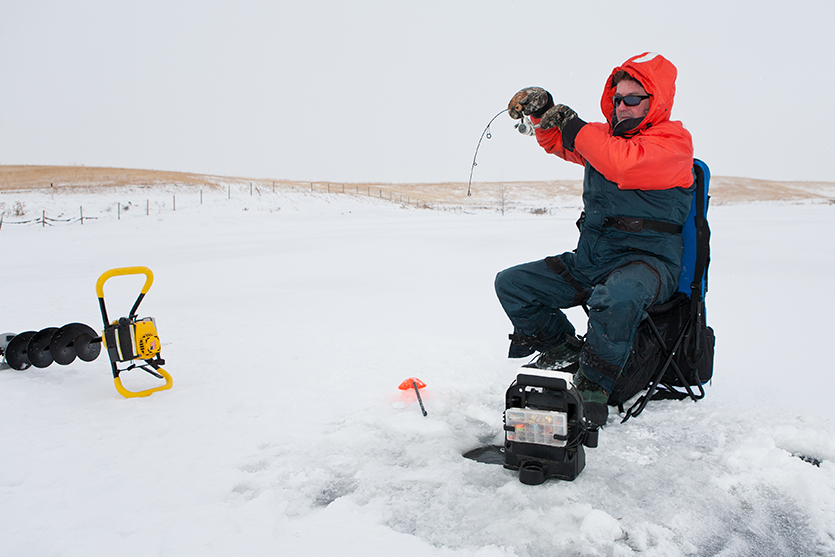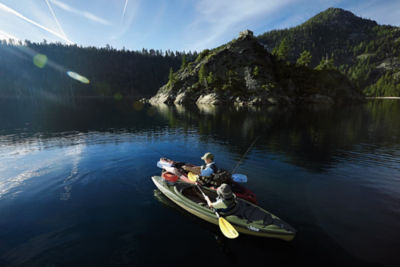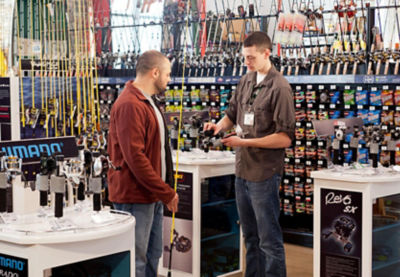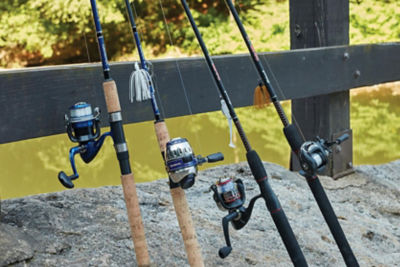Ice Fishing Guide for Beginners
New to ice fishing? Advancements in ice-fishing equipment, tackle and apparel can make just about any day on your local tundra feel like paradise.

Battle the fish or battle the elements? It's the age-old question that comes up every year when the surface of your favorite pond, lake or river turns to ice.
Sure, catching fish in the winter months is a thrill — just wondering what will come up through that hole you dug while you reel is like unwrapping a gift — but the thought of parking yourself exposed on a 5-gallon bucket with a rod in your hands while getting hammered by snow, sleet and wind? Well, that can force the hardiest of anglers to give up before the day even starts.
Thankfully, today's advancements in ice-fishing equipment, tackle and apparel can make just about any day on your local tundra feel like paradise.
So if you're a novice to the sport — or even an experienced seasonal fisherman who's curious about getting outside when everyone else is hibernating — here are some basic items you'll need to help make sure your time in the deep freeze is productive and fun.
Gimme Shelter
The days of homemade wood cabins, mounted on sleds is largely gone. Today, affordable and easy-to-assemble ice shelters dot ice surfaces everywhere. These structures, engineered in flip-down ("clam style") and squared or hexagonal front-access designs, can be setup or collapsed swiftly and help help you shielded from the elements.
Ranging from 1- to 8-person capacities, ice shelters are made with rugged, multi-layer fabrics that offer breathable, thermal insulation. Pair it with a portable space heater and you'll fish in creature comfort, regardless of the brutal temperatures and conditions outside.
Drill, Baby, Drill
Unless you enjoy doing major cardio with a pick ax or a shovel, it's advisable to invest in an ice auger. These screw-action tools come in manual or power designs (electric, propane or gas), and offer a range of diameters. Manual augers are the most cost effective for newcomers to the sport. They commonly drill 4- to 8-inch holes in the ice. Power augers can drill 10-inch holes and are more efficient, but also heavier and need to be serviced periodically.
Plus, have an ice skimmer handy to keep the hole clear, and overlay a rubber floor mat with a cut-out opening around the hole to retard ice buildup.
Safety First...Last..and In Between
Sometimes, in the flurry of excitement that comes with catching fish, it's easy to forget you're standing on a very unpredictable surface.
Once you've chosen your spot to fish, you'll need these key safety items:
- Spud bar (or ice chisel): These walking sticks, which come in 4- or 5-foot lengths, are used to test ice in front of you as you walk.
- Safety picks: These floatable handles are connected by a cord and worn on your body. Safety picks are designed to help you if you fall through the ice — grab them and jab them into the ice to help pull yourself out.
- Throw bag: this includes a rope and a foam float and can be tossed to an angler who has fallen through the ice.
- Safety whistle
- Personal Flotation Device (PFD): This streamlined design can be inflated by a CO2 canister. A foam-style vest can also be worn, but can be clumsy while fishing.
Tipping Points
Once your shelter is up and your holes are drilled, it's time to gear up.
"If it can be caught, it can be caught through the ice," says Teeg Stouffer of Omaha, Neb., founder of the conservation group Recycled Fish, which partners with DICK'S Sporting Goods in outdoor program projects. Stouffer is also a member of Ice Team, a leading promoter of wintertime angling.
For novices, wax worms tipped to 1/64 oz. jigheads are easy to rig and highly effective on just about anything that swims. Use lightweight and affordable spinning reel combos (ice fishing rods are usually only 2.5 to 3 feet long) with 2- to 4-pound line if you're targeting panfish (crappie, bluegill, rockbass or perch) and 6- to 8-pound braided line if zeroing in on predatory species like walleye, sauger, largemouth and smallmouth bass, pickerel or northern pike.
Tip-ups, which use only a spool of line attached to a platform trigger mechanism that straddles the hole in the ice, offer a more finesse-style method of fishing. Once the fish bites, the angler sets the hook using a hand-over-hand retrieval method. This technique is a bit more advanced for some, but can be learned quickly.
Small plastics with swim tails (grubs) or hardbaits (1/4 oz. spoons and lipless crankbaits) are also a great way to go. These should be fished using a vertical presentation (twitching the bait slightly up and down) to create vibration or generate flash, which gets the attention of suspended fish. Note that during the deep freeze, most species of fish tend to hover off the bottom so keeping your lure a few cranks off of it in the strike zone is crucial.
Newcomers to the sport can also use tried-and-true live bait options like minnows (hook them behind the dorsal fin for the best presentation) or leeches. But these will need to be re-rigged more often.
Generally, cold temperatures mean fish bite more subtly so be attentive and watch that rod tip for any movement. You can use a rod holder, but double-check that drag and always be ready to put that cup of coffee down and set the hook.
Etiquette is Always in Style
Like any group activity, Stouffer says ice fishing involves a couple of key rules to ensure proper respect for others who are also out enjoying the sport.
"First, do not drill your holes too close to another angler," he says. "In open water, you don't know if someone's just been there before you. But in ice fishing, you see the hole, so you know. Try to give at least a 30-foot berth to the next guy whenever possible."
Second, Stouffer says the days of catch and kill are changing. Whereas most ice fishing 10 years ago was done for sustenance, groups like Ice Team are promoting the same catch-and-release approach most bass anglers use when fishing during the warmer months, particularly during ice fishing derbies.
"Now, it's about selective harvest," he says. "With modern techniques and today's electronics, we are more efficient predators than ever. A handful of guys could severely impact a population of fish on a body of water over a season. As we continue to grow the sport by introducing newcomers, we are encouraging folks to be good stewards and save some for the other guy by harvesting a few mid-sized fish and releasing the biggest fish to preserve trophy genetics."
Before you head out, make sure you have the ice fishing gear you need.
As a reminder, please check and re-check weather conditions and review your state's regulations before you head out for your day on the ice. Tight lines and good luck!








